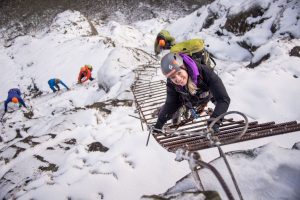Via Ferrata is a mountain climbing technique that allows people to climb with some safety from falling. This can be done on routes of varying difficulty, from easy scrambles to challenging rock climbs. In recent years, Via Ferrata has experienced a surge in popularity as an activity that offers something totally different to your standard climbing experience. The Dolomites area of Italy is particularly renowned for its Via Ferrata both in terms of quality and quantity. They are extremely popular with tourists wanting an adventure they can’t get anywhere else. You don’t need any formal climbing or mountaineering experience but be aware there is still unquestionable danger involved, which is part of their appeal for many people
Via Ferrata is a system of metal rungs and cables, fixed to a mountainside.
It allows climbers of all levels to experience the thrill of a mountain ascent in relative safety by providing protection from falls.
Via Ferrata is a system of metal rungs and cables, fixed to a mountainside. It allows climbers of all levels to experience the thrill of a mountain ascent in relative safety by providing protection from falls.
This form of climbing was developed during World War I by Italian soldiers looking for an easier way to reach the enemy’s front lines. As the war progressed, more men were needed on the front line and so they began training climbers in mountaineering skills such as rock climbing, ice climbing and crevasse rescue techniques. Some soldiers gave up their rifles in order to carry more equipment up with them which also included ladders made out of ropes tied together with wooden rungs inserted into them! These were known as “fixed ropes”. The first civilian climbers started using these fixed ropes too but it wasn’t until 1922 that someone came up with idea of attaching metal rungs directly onto rocks instead!
In recent years, Via Ferrata has experienced a surge in popularity as an activity that offers something totally different to your standard climbing experience. It’s a safe way to climb mountains and can be enjoyed by anyone with a sense of adventure.
The essence of VF is real adventure: it’s all about the journey, not just getting up there. You’re not always certain where you’re going next, or how you’ll get there, so that constant unknown factor makes it exciting and challenging at the same time.
The Dolomites area of Italy is particularly renowned for its Via Ferrata both in terms of quality and quantity. They are extremely popular with tourists wanting an adventure they can’t get anywhere else.
Via Ferrata is a system of metal rungs and cables, fixed to a mountainside. It allows climbers of all levels to experience the thrill of a mountain ascent in relative safety by providing protection from falls. The route requires only basic climbing equipment such as helmet, harness, gloves and via ferrata set (consisting of two carabiners and lanyard).
You don’t need any formal climbing or mountaineering experience to try via ferrata, but be aware there is still unquestionable danger involved, which is part of their appeal for many people.
You should read and follow all instructions given by local guides before embarking on any via ferrata activity. The main risks are falling from a height and abseiling down if you get stuck at the top. If you’ve got a fear of heights, this could be an ideal way to overcome it. Get more information at Ferrata climbing Lake District
You will be equipped with a harness, helmet and lanyard which gives you the freedom to move around without needing to worry about falling off the mountain side (providing you follow the instructions).
If you’re looking for an activity that is exciting and fun, then this is it!

Walking boots or approach shoes are sufficient on most routes but some might require rock climbing shoes too. If you’re tackling a multi-pitch route (something that takes you to more than one peak) then grabbing a backpack may prove useful too. Most routes don’t require much gear though so it’s important not to overburden yourself because this will make the ascent harder work.
Once you’ve reached the top, it’s time to enjoy the view. There are usually a few places where you can stop for lunch and take in the surroundings with your friends before starting down again. Some routes require scrambling over rocks or doing some easy climbing on old mine shafts but generally speaking – they’re fairly straightforward affairs as long as you follow common sense!